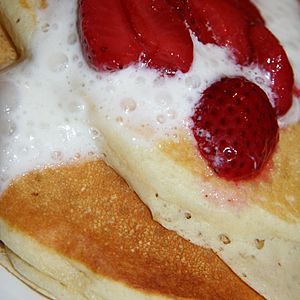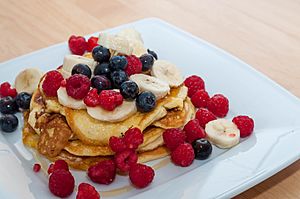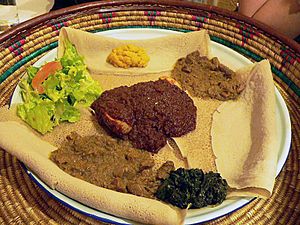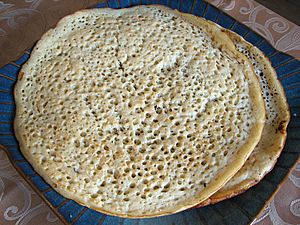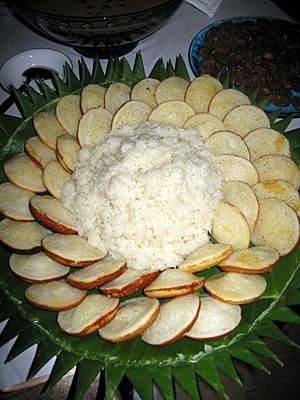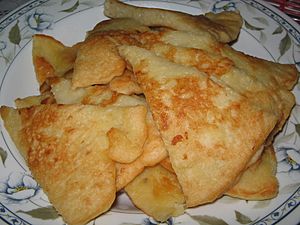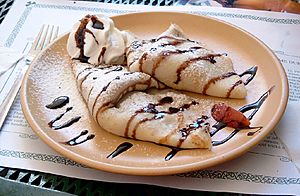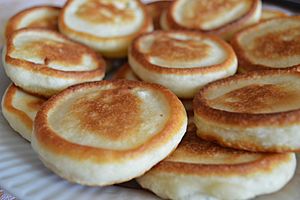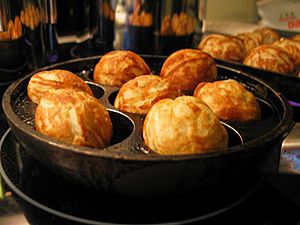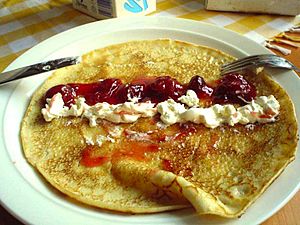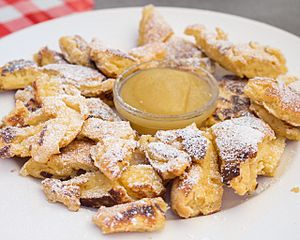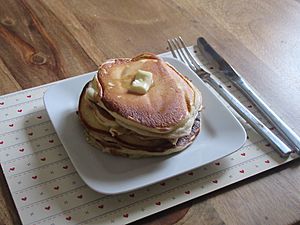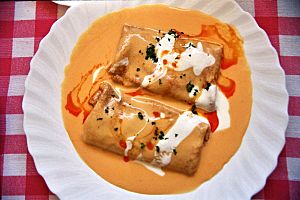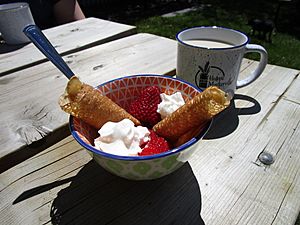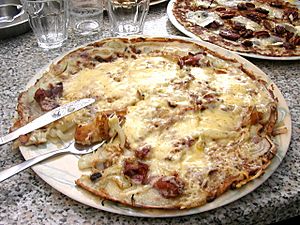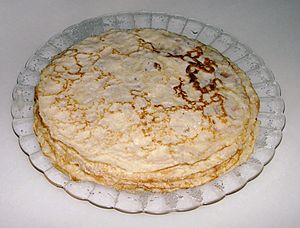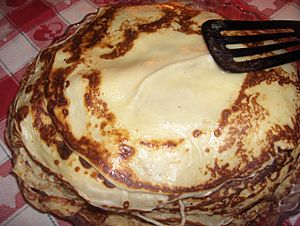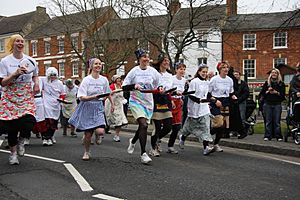Pancake facts for kids
Pancakes are a yummy, flat kind of bread cooked on a frying pan. You might also hear them called "griddlecakes," "hotcakes," or "flapjacks." They come in many styles, from thin French crêpes to thicker, fluffy pancakes. In English-speaking countries, they're usually called "pancakes" and are often thin. But in Mexico, they're called "hotcakes" and are often thicker! Most pancakes are "quick breads," meaning they use baking powder to rise quickly, but some use yeast or fermented batter.
Pancakes are enjoyed in many places for breakfast or dessert. People often top them with sweet things like maple syrup, jam, or sugar. But sometimes, they're served with savory (not sweet) toppings or fillings, like meat!
Contents
How Pancakes Are Made
Most pancakes use a "raising agent" to make them fluffy. This is usually baking powder, along with eggs, flour, and milk. These ingredients are mixed to make a thick batter. This batter is then poured onto a hot pan that has a little cooking oil or melted butter. The batter spreads out to make a cake about 1 centimeter (about 1/3 inch) thick.
As the pancake cooks, the raising agent creates bubbles on the uncooked side. This shows it's ready to be flipped (turned over)! When they're done, pancakes are very light and airy. They are often served for breakfast with maple syrup, butter, or fruit. Some pancakes, like those from Vermont, might have other grains like oatmeal or buckwheat flour mixed with the wheat flour. These need more baking powder to rise. They have a rougher texture and a deeper, nutty flavor.
Serving Pancakes
Most pancakes are cooked one side at a time. The cook flips them over halfway through. Tossing a pancake high in the air can be tricky, but good cooks make it look easy!
In North America (like Canada and the United States), you can make pancakes sweet or savory. You can add things like blueberries, strawberries, cheese, or bacon to the batter. Bananas or chocolate chips are also popular additions. British pancakes are often stuffed with sweet or savory fillings after they're cooked. Both types are usually sweetened after cooking with syrup or powdered sugar.
In Canada and the United States, pancakes are a common breakfast food made at home. You can also find them in restaurants and diners. There's even a restaurant chain called International House of Pancakes (IHOP) that specializes in them, with over 1,000 locations!
In Britain, pancakes are often eaten as a dessert or with a main meal. They are also traditionally eaten on Shrove Tuesday, which is also known as "Pancake Day". This day used to be a way to use up rich foods like fat and eggs before Lent, a time when people would eat simpler meals. Many schools and charities organize events on Pancake Day.
In the Netherlands, pancakes are called pannekoeken and are eaten for dinner. Pancake restaurants are popular family spots, serving many kinds of sweet, savory, and stuffed pancakes. The Netherlands also has tiny, fluffy pancakes called "poffertjes." They are cooked on a special pan with many small holes. Poffertjes are served with icing sugar and melted butter. You can often find a poffertje stall at Dutch markets.
In Sweden and Finland, it's a tradition to eat yellow pea soup followed by pancakes on Thursdays. Smaller pancakes, sometimes called "silver dollar" pancakes, are used as appetizers instead of crackers.
Banana pancakes are a favorite among travelers in many Asian countries like Thailand, Vietnam, India, and China.
Pancake Varieties Around the World
Africa
Horn of Africa
In the Horn of Africa (like Ethiopia and Somalia), pancakes are called injera or canjeero. Injera is a flatbread made with yeast that has a unique, slightly spongy texture. It's usually made from teff flour and is a national dish in Ethiopia and Eritrea. Canjeero is a similar flatbread eaten in Somalia and Yemen.
In Ethiopia and Eritrea, injera is served with stews called wat or with salads. You use your right hand to tear off small pieces of injera to pick up the food. The injera underneath soaks up all the yummy juices, and you eat that too! So, injera is like your food, your fork, and your plate all at once.
Lahoh is a pancake-like bread from Somalia, Djibouti, and Yemen. It's often eaten with honey, ghee (a type of butter), and tea. For lunch, lahoh might be eaten with curry or soup.
Kenya
In Kenya, pancakes are eaten for breakfast instead of bread. They are usually served plain, with sugar already mixed into the batter to make them sweet. Kenyan pancakes are similar to English pancakes and French crêpes.
South Africa
In South Africa, a "pancake" is like a crêpe. In Afrikaans, it's called a pannekoek. They are often made on gas stoves and eaten on cold, wet days. Pannekoeke are usually served with cinnamon-flavored sugar and sometimes lemon juice. They are a popular food at church events.
Plaatkoekies (meaning "plate cookies") are like American "silver dollar" pancakes.
Uganda
In Uganda, pancakes are made with bananas, which are a main food in the country. They are usually served for breakfast or as a snack.
Asia
Banana pancakes are a popular item in cafes for travelers in Asian countries like Malaysia, Thailand, Cambodia, Vietnam, India, and China. This has even led to the term Banana Pancake Trail for popular travel routes.
China
Chinese pancakes can be savory or sweet. They are usually made with dough, not batter. The dough is mostly water, flour, and vegetable oil. They can be served as a side dish, often with duck, or as a snack topped with scallions and a hot and sour sauce.
India
India has many kinds of pancakes, differing in taste and main ingredients. All are made without added raising agents.
In North India, pancakes are called cheela. Sweet cheela use sugar or jaggery (a type of sugar) with wheat flour. Salty cheela are made from gram flour or green gram paste and sometimes have paneer (a cottage-style cheese) on top.
Dosa, appam, and uttapam are pancakes made in South India. They are made by fermenting rice batter and split urad beans (black lentils) mixed with water. Meetha pooda – sweet pancakes often eaten with pickles and chutney – are a common breakfast in the Punjab. Many pitha in Assam are types of pancakes served during festivals like Bihu. The Bengali semi-sweet pancake pati-shapta is filled with grated coconut or thickened milk.
In Western India, the multi-grain thalipeeth is popular. In Goa, a traditional crêpe-like pancake called alebele is eaten at tea-time. It's usually filled with jaggery and coconut.
Indonesia
In Indonesia, pancakes are called panekuk. The Indonesian pancake serabi is made from rice flour and coconut milk. It's often served with kinca, a thick, brown coconut sugar syrup. Other toppings can include sugar, ground peanuts, sliced bananas, jackfruit, and chocolate. Some even have cheddar cheese, corned beef, shredded chicken, or sausage. Other Indonesian pancakes include dadar gulung, kue ape, kue apem, kue cubit, kue cucur, kue terang bulan, and murtabak.
Japan
In Japan, okonomiyaki are made from flour, egg, cabbage, and other ingredients. Oyaki are pancakes often filled with anko (sweet bean paste), eggplant, or a leafy vegetable called nozawana. Dorayaki are like a sandwich made from Western-style pancakes with anko inside. Sweet crepes are also very popular.
Japanese chefs have also created a taller, fluffier pancake inspired by American pancakes. You can find these in places like Singapore, Toronto, Australia, and the UK.
Korea
In Korea, pancakes include jeon, pajeon, bindaetteok, kimchijeon, and hotteok. These can be served any time of day as side dishes or snacks. Some variations use the pancake batter to deep-fry vegetables, meat, or fish.
Malaysia and Singapore
The traditional Malay pancake in Malaysia and Singapore is called lempeng. It's cooked much like an American pancake but without a rising agent. It's usually served for breakfast with curry, rendang (a rich meat dish), or sambal (a chili sauce).
Nepal
In Nepal, the Newar people have a savory rice pancake called chataamari. It's cooked with meat or eggs on top. This dish is also known as the Newari Pizza because it's served and eaten like a pizza. It can also be served plain.
Pakistan
In Pakistani cuisine, rishiki is a pancake, a bit thicker than a crêpe. It's made from whole wheat flour, water, and eggs, and usually served with honey. It's common in the far north and is a main food in Chitrali cuisine.
Philippines
In the Philippines, traditional dessert pancakes include salukara, a rice pancake made from sticky rice, eggs, and coconut milk. The batter is baked over hot coals in a clay pot lined with banana leaves. Salukara is a type of bibingka (Philippine baked rice cakes). Panyalam, a similar rice pancake from Mindanao, is deep-fried instead of baked.
Traditional savory pancakes in the Philippines (including omelettes) are generally called torta. Examples include tortang talong (eggplant omelette) and okoy (a pancake made of battered shrimp, pumpkin, or sweet potatoes).
American-style pancakes, or "hotcakes," are also popular. They are often eaten for breakfast but can also be an afternoon snack. Street vendors sometimes sell small hotcakes topped with margarine and sugar.
Vietnam
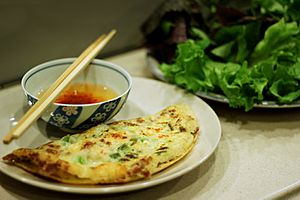
In Vietnamese cuisine, there are many traditional pancakes. These include bánh xèo in the north, bánh khọt in the south, and bánh căn and bánh khoái in central Vietnam.
Europe
Austria, Czech Republic, Romania, Slovakia, and former Yugoslavia
In Austria, the Czech Republic, and Slovakia, pancakes are called palatschinke, palačinka, and palacinka. In Romania, they are called clătită. In countries of former Yugoslavia, they are called palačinka. These words come from the Latin word placenta, meaning "cake." These pancakes are thin and filled with fruit jams (like apricot, plum, or strawberry), chocolate sauce, or hazelnut spread. A special Austrian pancake is Kaiserschmarrn, which includes raisins, almonds, or apple pieces, is torn into pieces, and sprinkled with powdered sugar.
Belarus, Russia, Ukraine
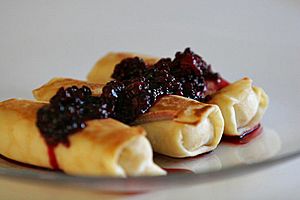
Eastern Slavic countries have a long history of making pancakes. In Belarus, Russia, and Ukraine, pancakes can be for breakfast, an appetizer, a main meal, or dessert.
Blini and mlynci are thin pancakes, a bit thicker than crêpes. They are made from wheat or buckwheat flour, butter, eggs, and milk, with yeast added. Blini cooking goes back to old traditions, like the "pancake week" celebrated in winter before Lent. In ancient times, blini were a symbol of the sun because of their round shape.
Blintzes (blinchiki) are thin crêpes made without yeast. Filled blintzes are also called nalysnyky. They are filled with things like jam, fruits, quark (a type of cheese), cottage cheese, potato, cooked meat, or even mushrooms and onions. The filling is rolled into the cooked blintz, which is then lightly fried or baked again.
Small, thick pancakes are called oladyi. Their batter can have additions like apple or raisins.
Denmark
Æbleskiver are traditional Danish pancakes shaped like spheres (balls). The name means "apple slices," but they don't usually have apples in them! Æbleskiver are cooked on a special pan with round holes. Batter is poured into the holes, and as they cook, they are turned with a knitting needle or fork to make them round. Æbleskiver are not sweet on their own but are usually served with raspberry, strawberry, or blackberry jam and powdered sugar.
Finland
Finnish pancakes are very similar to Swedish ones. They are called lettu or ohukainen. In Finland, pancakes are usually eaten as dessert with whipped cream, jam, sugar, or vanilla ice cream. There's also pannukakku, which is a thicker pancake baked in an oven, not on a frying pan. Ålandspannkaka is a very thick oven-baked pancake from Åland that includes cardamom and rice pudding.
France, Belgium, Italy, Portugal, Switzerland (and Latin America)
Crêpes are popular in France, Belgium, Switzerland, and Portugal. They are made from flour, milk, and eggs and are very thin. They can be served with sweet fillings (like fruit, ice cream, jam, chocolate spread) or savory fillings (like cheese, ham, or spinach). In Europe, crêpes are often sold at special stands. In Italy, they are called crespelle. In Brittany, France, a galette is a large, thin pancake made of buckwheat flour, often cooked on one side only.
Crêpes are also popular in many South American countries like Argentina, Brazil, and Chile. They are eaten with sweet fillings (like marmalade or dulce de leche) or savory fillings (like ground meat or vegetables).
They have also become popular in East Asian countries, including Japan, South Korea, the Philippines, Thailand, and China. They are often served with whipped cream and fruits.
Farinata are popular in Mediterranean areas, like Nice. Also called socca, these pancakes are made from chickpea flour and seasoned with black pepper. They are a popular street food in Nice.
Germany
German pancakes are known as Pfannkuchen. They are generally thicker than French crêpes and usually served with sweet or sometimes savory fillings. They don't usually use a raising agent or yeast. Fried apple rings covered in pancake dough and served with sugar and cinnamon are called Apfelküchle. Kaiserschmarrn, a thick but light pancake popular in Bavaria, is usually torn into pieces, filled with fruits or nuts, sprinkled with powdered sugar, and served with a fruit sauce. It's believed this was first made for Kaiser Franz Joseph I of Austria.
In Swabia, sliced pancake strips (flädle) are often served in soup.
Great Britain
England
English pancakes use plain flour, eggs, and milk. The batter is runny and forms a thin layer in the pan. It might bubble a little, but the pancake doesn't rise much. English pancakes are similar to French crêpes. They can be eaten as a sweet dessert with lemon juice and sugar, or with golden syrup. They can also be wrapped around savory fillings for a main meal. On Shrove Tuesday, it's a tradition to eat pancakes with lemon juice and sugar. Yorkshire pudding is made from a similar recipe but is baked instead of fried. It rises because the air beaten into the batter expands.
Scotland
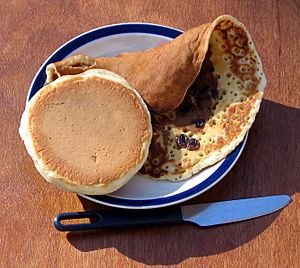
Pancakes in Scotland (also called Scotch pancakes or Scottish pancakes) are more like the American type. In some parts of Scotland, they are called drop scones. They are made from flour, eggs, sugar, buttermilk or milk, salt, baking soda, and cream of tartar. They are smaller than American or English pancakes, about 9 cm (3.5 inches) wide. They are made by dropping batter onto a griddle. They can be served with jam and cream or just with butter. In Scotland, pancakes are usually served at teatime.
Wales
Welsh pancakes, called crempog, vary a lot. Generally, they are thick and stacked to make a tall cake. Some are like American pancakes, others might use yeast or oatmeal, and some are like Scotch pancakes. Crumpets and pikelets are sometimes seen as types of pancakes.
Greece
Greek pancakes are called tiganites. They are popular across Greece and Cyprus. They are a bit thicker than crêpes and can be sweet or savory. Their main ingredients are flour, olive oil or butter, milk, and eggs. They are usually drizzled with honey and cinnamon, and sometimes topped with cheese, nuts, fruits, or vegetables. In Cyprus, small shops called creperies sell both savory and sweet crêpes. Tiganites can be served for breakfast or dessert.
Hungary
In Hungary, pancakes called palacsinta are made from flour, milk or soda water, sugar, and eggs. Sweet wine can be added to the batter. The filling is usually jam, sugared walnuts or poppy seeds, sugared cottage cheese, or cinnamon powder. But meat and mushroom fillings are also used, like in Hortobágyi palacsinta. Gundel palacsinta is a Hungarian pancake filled with walnuts, zest, raisins, and rum, served in chocolate sauce and often set on fire (flambéed) at the table. Hungarian pancakes are served as a main dish or a dessert.
Iceland
Icelandic crêpe-like pancakes are called pönnukaka. Smaller, thicker pancakes like North American ones are called lumma or skonsa. Pönnukökur are usually cooked on a special Icelandic pancake pan that makes them very thin. They are traditionally served rolled up with sugar or folded with jam and whipped cream. If you eat them at a café, they might have ice cream instead.
In Iceland, North American-style pancakes are sometimes cut in half and used as sandwich bread, similar to Icelandic flatbread.
Netherlands
In the Netherlands, pancakes are known as pannenkoeken and are mostly eaten for lunch and dinner. Pancake restaurants are popular with families and serve many sweet, savory, and stuffed kinds. Pannenkoeken are slightly thicker than crêpes and quite large, about 30 cm (12 inches) wide. The batter uses eggs, and fillings include sliced apples, cheese, ham, bacon, and candied ginger. Stroop, a thick syrup made from sugar beets, is also popular, especially with bacon. Poffertjes are another Dutch quick bread, similar to American pancakes but sweeter and much smaller. They are made in a special dimpled pan and contain baking powder, making them softer inside than pannenkoeken.
Poland
In Poland, thin crêpe-style pancakes are called naleśniki. They are usually rolled and served with various savory or sweet fillings as a main dish or dessert. Sweet fillings include fresh fruits (like blueberries), jams (often apple jam), and soft white cheese with sugar. Savory fillings include fried vegetables, fried chicken, minced meat, spinach, and other ingredients like potatoes, mushrooms, cabbage, or ham. Another Polish dish like pancakes is racuchy. They are smaller and thicker than naleśniki and can be filled with apple slices.
Spain
Spanish pancakes are called frixuelos or filloas and are very popular in northwest Spain. They are made from flour, milk, and eggs. They are thin and usually served with a lot of sugar or honey. They are a typical sweet dessert for Carnival in Galicia, Asturias, and León.
Sweden, Norway
Nordic pancakes are similar to French crêpes. In some Nordic countries, they are served with jam or fruit, especially lingonberries, as a dessert with savory fillings. Traditional Swedish pancakes can be quite unique. Besides the usual thin pancakes, called pannkakor, which are like French crêpes and often served with whipped cream and jam, Swedish cuisine also has plättar — very small pancakes. These are usually fried in a special pan called a "plättlagg," which has indentations to make several at once.
Another type is ugnspannkaka (oven pancake), which is very thick and baked in the oven, similar to German pancakes. There's also a version with fried pork in the batter, called fläskpannkaka (pork pancake). Potato pancakes called raggmunk contain shredded raw potato. Raggmunk are traditionally eaten with pork rinds and lingonberry jam. A special Swedish pancake is saffron pancake from Gotland, made with saffron and rice, baked in the oven. It's common to add lemon juice to the sugar for extra taste. Pancakes are often served after a soup. Another special "Swedish pancake" is the äggakaka (eggcake), which is much thicker and harder to make without burning. It's made in a frying pan, about 4-5 cm (1.5-2 inches) thick, and served with lingonberries and bacon. The Norwegian version is commonly eaten for dinner, traditionally with bacon, jam (usually bilberry), or sugar.
North America
Costa Rica
Costa Rican chorreadas are similar to cachapas.
Guatemala
Guatemalan pancakes are called panqueques. They are made with the same ingredients as American pancakes. The toppings are usually fruits and honey. They are a very popular breakfast in Guatemala. Depending on the region, the panqueque can be thin like a crêpe or fluffy like a North American pancake.
Mexico
Mexican hotcakes are similar to American pancakes. Crêpes became popular in the late 1800s after the French introduced them. Hotcakes are often made with cornmeal, or a mix of cornmeal and wheat flour. Hotcakes are popular breakfast items in restaurants and are often sold by street vendors in cities and at local celebrations. They are also sold at fairs; vendors sell a single hotcake topped with different sauces like condensed milk, fruit jam, or a sweet goat milk spread called cajeta.
United States and Canada
American and Canadian pancakes (sometimes called hotcakes, griddlecakes, or flapjacks) are usually served for breakfast. They come in a stack of two or three, topped with real or fake maple syrup and butter. They are often served with sides like bacon, toast, eggs, or sausage. Other popular toppings include jam, peanut butter, nuts, fruit, honey, powdered sugar, whipped cream, and molasses. When pancakes are served as a dessert, toppings like ice cream, chocolate syrup, and various fruits are often used.
The thick batter contains eggs, flour, milk, and a raising agent like baking powder. The batter can have ingredients like buttermilk, blueberries, strawberries, bananas, apples, chocolate chips, cheese, or sugar added. Spices like cinnamon, vanilla, and nutmeg can also be used. Yogurt can be added to make the pancakes moist. Pancakes can be about 1 cm (⅓ inch) thick and about 10 cm (4 inches) wide.
Varieties of American and Canadian pancakes
Bannock is a traditional food for many of North America's first peoples. The European version was traditionally made of oatmeal. The Aboriginal version was made of corn, nut meal, and plant bulb meal. Each region had its own type of flour and fruit. Today, bannock is most often deep-fried, pan-fried, or oven-baked.
Johnnycake is a cornmeal flatbread that was an early American main food. It is still eaten in the West Indies and Bermuda. Modern johnnycakes are often linked to Rhode Island foods. A modern johnnycake is fried cornmeal gruel, made from yellow or white cornmeal mixed with salt and hot water or milk, and often sweetened.
Yaniqueques are a Dominican Republic version of the johnnycake. They are a fried bread, not a pancake, and are a popular beach food.
Sourdough was used by gold prospectors and pioneers to make pancakes without buying yeast. Prospectors would carry a pot of sourdough to make pancakes and bread, as it could last forever, needing only flour and water to refresh it. Sourdough pancakes are now a special food in Alaska. You can also find them in many American pancake restaurants.
A silver dollar pancake is a pancake about 5 to 7 cm (two to three inches) wide, just a bit bigger than old silver dollar coins. This is usually made by frying a small spoonful of regular pancake batter. One serving often has five to ten silver dollar pancakes.
German pancakes or Dutch baby pancakes served in American pancake restaurants are bowl-shaped. They are eaten with lemons and powdered sugar, jam, or caramelized apples. A David Eyre's pancake is a variation named after an American writer.
Toutons are small, tall pancakes traditional in Newfoundland. They are usually served with dark molasses.
Oceania
Australia and New Zealand
In Australia and New Zealand, small pancakes (about 75 mm wide) called pikelets are eaten. They are traditionally served with jam or whipped cream, or just with butter, at afternoon tea. They are made with milk, self-raising flour, eggs, and a little icing sugar.
In New Zealand, very thin, crêpe-like pancakes (about 20 cm wide) are served with butter, or butter and lemon, sugar, then rolled up and eaten.
American-style pancakes are also popular. They are eaten for breakfast or as a dessert, with lemon juice and sugar, butter and maple syrup, stewed fruits like strawberries and cream, ice cream, or mascarpone cheese.
South America
Brazil
Tapioca or beiju are unleavened pancakes made from cassava starch flour. They are a bit thicker than crêpes and can be eaten plain or with sweet or savory toppings. Tapioca flour needs to be wet and strained to become a coarse flour. When heated on an ungreased pan, the starchy grains stick together to form a flatbread that looks like a grainy pancake. Popular tapioca toppings include melted butter and dried, shredded coconut.
Panquecas are generally made from cow's milk and wheat flour. They are usually eaten with savory fillings as rolls, though dessert panquecas also exist. Common fillings include shredded, seasoned chicken breast with tomato sauce, and ground beef. Both are often topped with Parmesan cheese. Vegan recipes also exist, often using soy protein. Savory panqueca is usually eaten for lunch or dinner with white rice and salad.
The Brazilian pancake blinis is made from a mix of coconut milk and puba, a paste from fermented cassava. This is more common in Northern and Northeastern Brazil. This pancake is more watery and has a stronger flavor than unfermented tapioca.
Colombia and Venezuela
Cachapas are corn pancakes, popular in Colombian and Venezuelan cooking.
Pancake Restaurants
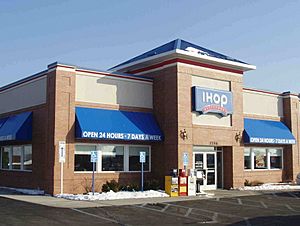
In the US, Mexico, and Canada, the restaurant chain International House of Pancakes serves pancakes all day. The Original Pancake House is another chain of pancake restaurants across the US.
The popularity of pancakes in Australia has led to restaurants like Pancake Parlour and Pancakes on the Rocks. In British Columbia and Alberta, Canada, the restaurant chain De Dutch serves Dutch-style pannenkoeken.
Pancake Syndrome
Pancake syndrome is an allergic reaction some people have after eating pancakes in tropical areas. This can happen if certain tiny mites get into the flour.
Pancake Day
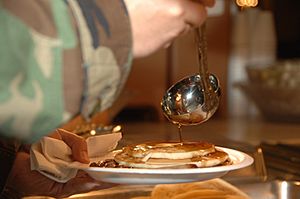
Pancakes are traditionally eaten on Shrove Tuesday, which is called "Pancake Day" in Canada, the United Kingdom, Ireland, New Zealand, and Australia. In Ireland and Scotland, it's "Pancake Tuesday." (In the United States and France, it's known as Mardi Gras or Fat Tuesday.) Historically, pancakes were made on Shrove Tuesday to use up the last of the fat or lard before Lent, a time when people would not eat rich foods or meat.
Charity and school events are often held on Pancake Day. In a "pancake race," each person carries a pancake in a frying pan. Runners must toss their pancakes as they run and catch them in the pan. This event is said to have started in Olney, England in 1445. A housewife was busy frying pancakes before the Lenten fast when she heard the church bells calling her to a service. Eager to go, she ran out of her house still holding the frying pan with the pancake, tossing it to keep it from burning.
Every Shrove Tuesday since 1950, the towns of Olney, England, and Liberal, Kansas, have competed in the International Pancake Race. Only local women can compete; they race, and their times are compared to find the international winner. In Olney, there are also races for schoolchildren and men.
The Rehab UK Parliamentary Pancake Race happens every Shrove Tuesday. Teams from the British Parliament (the House of Commons and the House of Lords) and the media compete. This fun relay race helps raise awareness for Rehab UK, a charity that helps people with brain injuries.
Gallery
-
Japanese okonomiyaki, a savory pancake with many ingredients
-
Danish æbleskiver being prepared
-
French socca fresh from the oven in Nice, France
-
An automatic pancake machine
-
Inuit bannock
-
A touton (upper-right) with other breakfast foods
Images for kids
-
Indonesian serabi
-
Filipino traditional salukara pancakes made from rice, coconut milk, water, and sugar
-
An Åland pancake (Ålandspannkaka), a traditional food in Åland.
-
Japanese okonomiyaki, a savory pancake with many ingredients
-
Swedish äggakaka with slices of pork belly, apples, and a bowl of lingonberries
-
Pancakes made in the shape of a heart on a frying pan
See also
 In Spanish: Panqueque para niños
In Spanish: Panqueque para niños



